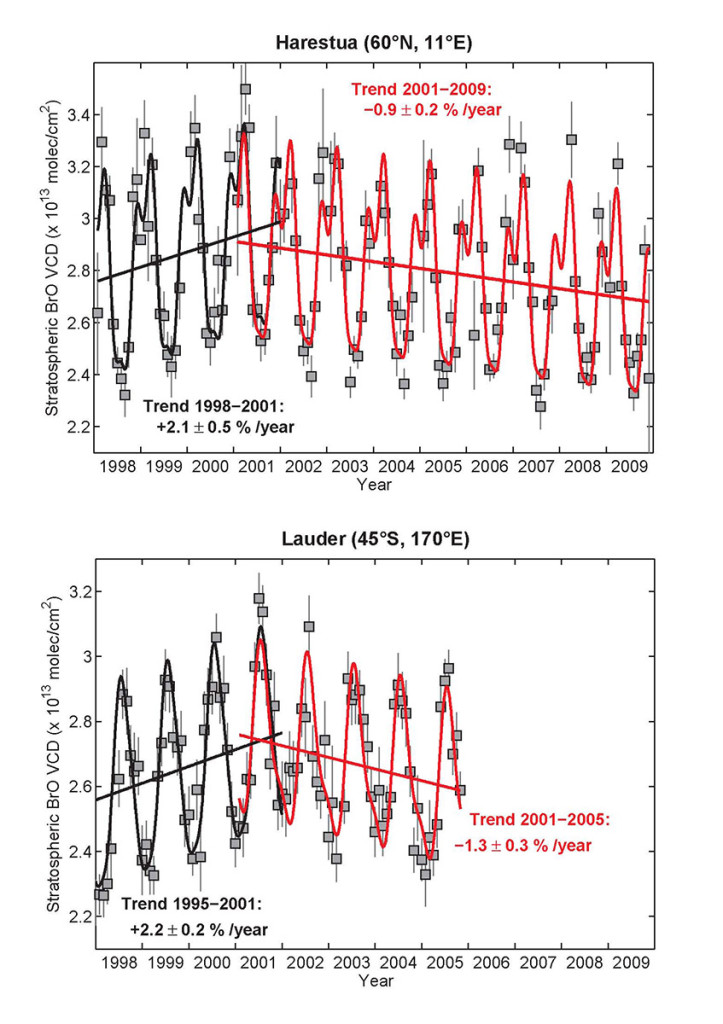Despite its low abundance in the atmosphere, stratospheric bromine contributes up to 25% to the global ozone loss due to its high ozone depletion potential [e.g., World Meteorological Organization (WMO), 2007]. The main sources of bromine in the stratosphere are natural and anthropogenic long-lived and very short-lived brominated organic compounds [e.g., Pfeilsticker et al., 2000; Salawitch et al., 2005]. Long-term observations by in-situ ground-based networks have revealed a decline in total organic bromine from long-lived species by 3 to 5% during the 1998-2004 period [WMO, 2007].

Figure 1: Trend analysis of stratospheric BrO columns over Harestua (60N, 11E; upper plot) and Lauder (45S, 170E; lower plot). More details in Hendrick et al. [2008].
In a recent study by Hendrick et al. [2008], the time evolution of stratospheric bromine monoxide (BrO) has been monitored since 1994 using UV-visible spectrometers operated at two stations of the NDACC: Harestua in Southern Norway (60N, 11E) and Lauder, New Zealand (45S, 170E). Results reveal a significant trend in stratospheric BrO evolving from positive values in the nineties to negative values in most recent years after 2000 (see Figure 1). Accounting for the mean age of air in the stratosphere, the decline in stratospheric bromine since 2002 is found to follow the reported decline of bromine long-lived source gases observed since the second half of 1998. These findings confirm that the impact of the Montreal Protocol restrictions on brominated substances have now reached the stratosphere. Continued high quality NDACC observations of BrO columns and profiles will allow to monitor the future evolution of this important ozone related trace gas. These observations also constitute a key reference for the validation of BrO measurements from recent atmospheric chemistry satellite instruments, such as SCIAMACHY, GOME, GOME-2, OMI, MLS and JEM/SMILES [e.g. Hendrick et al., 2009].
Following a decision endorsed at the 2009 NDACC Steering Committee in Geneva, total column and stratospheric profile BrO measurements performed as part of the NDACC UV-Visible Working Group will be archived in the NDACC data base. In an effort to homogenize data sets and minimize risks of bias and inconsistencies in the retrieved quantities, BrO profiles derived using a commonly agreed Optimal Estimation inversion tool including treatment of the BrO diurnal photochemistry [Schofield et al., 2004; Hendrick et al., 2007] can be centrally produced at BIRA-IASB in agreement with measuring teams. Furthermore, intercomparisons of both BrO slant columns and vertical profile inversion methods are ongoing, e.g. as part of the recent CINDI campaign (see related Hot News on CINDI), and should lead to future consolidation of the NDACC BrO data products.
References
Hendrick, F., M. Van Roozendael, M. P. Chipperfield, M. Dorf, F. Goutail, X. Yang, C. Fayt, C. Hermans, K. Pfeilsticker, J.-P. Pommereau, J. A. Pyle, N. Theys, and M. De Maziere (2007), Retrieval of stratospheric and tropospheric BrO profiles and columns using ground-based zenith-sky DOAS observations at Harestua, 60N, Atmos. Chem. Phys., 7, 4869-4885.
Hendrick, F., P.V. Johnston, K. Kreher, C. Hermans, M. De Maziere, and M. Van Roozendael (2008), One decade trend analysis of stratospheric BrO over Harestua (60N) and Lauder (44S) reveals a decline, Geophys. Res. Lett., 35, L14801, doi:10.1029/2008GL034154.
Hendrick, F., A. Rozanov, P. V. Johnston, H. Bovensmann, M. De Mazière, C. Fayt, C. Hermans, K. Kreher, W. Lotz, N. Theys, A. Thomas, J. P. Burrows, and M. Van Roozendael (2009), Multi-year comparison of stratospheric BrO vertical profiles retrieved from SCIAMACHY limb and ground-based UV-visible measurements, Atmos. Meas. Tech., 2, 273-285.
Pfeilsticker, K., et al. (2000), Lower stratospheric organic and inorganic bromine budget for the artic winter 1998/99, Geophys. Res. Lett., 27, 3305- 3308.
Salawitch, R. J., D. K. Weisenstein, L. J. Kovalenko, C. E. Sioris, P. O. Wennberg, K. Chance, M. K. W. Ko, and C. McLinden (2005), Sensitivity of ozone to bromine in the lower stratosphere, Geophys. Res. Lett., 32, L05811, doi:10.1029/2004GL021504.
Schofield, R., Kreher, K., Connor, B. J., Johnston, P. V., Thomas, A., Shooter, D., Chipperfield, M. P., Rodgers, C. D., and Mount, G. H.(2004), Retrieved tropospheric and stratospheric BrO columns over Lauder, New Zealand, J. Geophys. Res., 109, D14304, doi:10.1029/2003JD004463.
World Meteorological Organization (WMO) (2007), Scientific assessment of ozone depletion: 2006, Global Ozone Res. Monit. Proj. Rep. 50, Geneva, Switzerland.